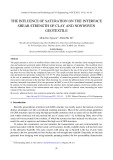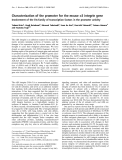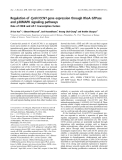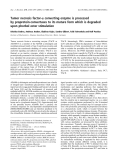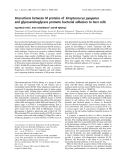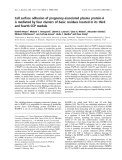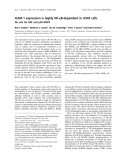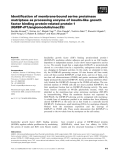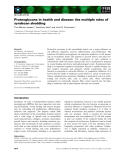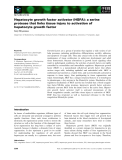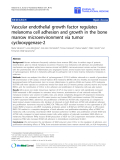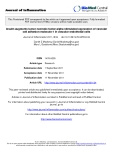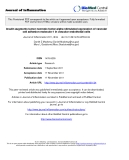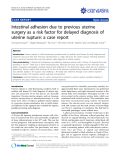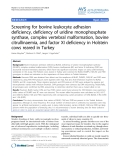
Adhesion factor
-
The paper presents a series of modified direct shear tests to investigate the interface shear strength between clay and nonwoven geotextile under different normal stresses and degrees of saturation.
 14p
14p  vifilm
vifilm
 24-09-2024
24-09-2024
 1
1
 1
1
 Download
Download
-
Integrin a2b1 is the major receptor for collagens in human tissues, being involved in cell adhesion and the control of collagen and collagenase gene expression. The collagen binding site of a2b1 has been localized to the a2 von Willebrand Factor type A (VWFA) domain (A-domain or I-domain) and the residues responsible for the interaction with collagen have been mapped. We report a study of a2 VWFA domain in which residue E318, which lies outside the collagen binding site, is mutated to tryptophan, showing that this is a gain-of-function mutation. ...
 9p
9p  research12
research12
 01-06-2013
01-06-2013
 35
35
 5
5
 Download
Download
-
Thea3b1 integrin is an adhesion receptor for extracellular matrix proteins including isoforms of laminin, and the changes of its expression level in various cancer cells are thought to cause their malignant phenotypes. We have cloned an approximately 4 kb DNA fragment of the 5¢-flanking region of the murinea3 integrin gene and analyzed its promoter activity.
 9p
9p  research12
research12
 23-04-2013
23-04-2013
 36
36
 3
3
 Download
Download
-
Cysteine-rich protein 61 (Cyr61/CCN1) is an angiogenic factor and a member of a family of growth factor-inducible immediate-early genes with functions in cell adhesion, pro-liferation and differentiation.We investigated the regulatory mechanisms and signaling pathways involved inCyr61/ CCN1gene activation in smoothmuscle cells.Treatment of these cells with sphingosine 1-phosphate (S1P), a bioactive lysolipid, increased rapidly but transiently the expression of theCyr61/CCN1gene at both themRNAandprotein levels....
 14p
14p  tumor12
tumor12
 20-04-2013
20-04-2013
 36
36
 2
2
 Download
Download
-
Tumor necrosis factor-a converting enzyme (TACE or ADAM17) is a member of the ADAM (a disintegrin and metalloproteinase) family of type I membrane proteins and mediates the ectodomain shedding of various membrane-anchored signaling and adhesion proteins. TACE is syn-thesized as an inactive zymogen, which is subsequently proteolytically processed to the catalytically active form.We have identified the proprotein-convertases PC7 and furin to be involved in maturation of TACE.
 8p
8p  fptmusic
fptmusic
 16-04-2013
16-04-2013
 37
37
 3
3
 Download
Download
-
Several microbial pathogens have been reported to interact with glycosaminoglycans (GAGs) on cell surfaces and in the extracellularmatrix. Herewe demonstrate thatM protein, a major surface-expressed virulence factor of the human bac-terial pathogen, Streptococcus pyogenes, mediates binding to various forms of GAGs. Hence, S. pyogenesstrains expressing a large number of different types of M proteins bound to dermatan sulfate (DS), highly sulfated fractions of heparan sulfate (HS) and heparin, whereas strains deficient in M protein surface expression failed to interact with these GAGs. ...
 9p
9p  fptmusic
fptmusic
 16-04-2013
16-04-2013
 44
44
 6
6
 Download
Download
-
The metalloproteinase pregnancy-associated plasma pro-tein-A (PAPP-A) cleaves a subset of insulin-like growth factor binding proteins (IGFBP), which inhibit the activities of insulin-like growth factor (IGF). Through this proteolytic activity, PAPP-A is believed to regulate IGF bioavailability in several biological systems, including the human repro-ductive system and the cardiovascular system. PAPP-A adheres to mammalian cells by interactions with glycos-aminoglycan (GAG), thus targeting the proteolytic activity of PAPP-A to the cell surface. ...
 11p
11p  dell39
dell39
 03-04-2013
03-04-2013
 53
53
 5
5
 Download
Download
-
The transcription factor nuclear factorjB(NF-jB) is an activator of multiple cytokines, chemokines and adhesion molecules, which are important in inflammatory diseases such as asthma, and is consequently considered as an attractive therapeutic target. In the present study, a con-stitutively active dominant version of IjBa,IjBaDN, was introduced into A549 pulmonary cells by adenovirus-mediated delivery. The dominant IjB, but not a null viral vector, prevented the induction of NF-jB-dependent transcription by both tumor necrosis factora(TNFa)and interleukin-1b(IL-1b). ...
 7p
7p  dell39
dell39
 03-04-2013
03-04-2013
 34
34
 4
4
 Download
Download
-
Insulin-like growth factor (IGF) binding protein-related protein-1 (IGFBP-rP1) modulates cellular adhesion and growth in an IGF⁄insulin-dependent or independent manner. It also shows tumor-suppressive activity in vivo. We recently found that a single-chain IGFB-rP1 is proteolytically cleaved to a two-chain form by a trypsin-like, endogenous serine protein-ase, changing its biological activities.
 13p
13p  dell39
dell39
 27-03-2013
27-03-2013
 42
42
 4
4
 Download
Download
-
Urinary glycoproteins are important inhibitors of calcium oxalate crystal-lization and adhesion of crystals to renal cells, both of which are key mech-anisms in kidney stone formation. This has been attributed to glycosylation of the proteins. In South Africa, the black population rarely form stones (incidence
 14p
14p  inspiron33
inspiron33
 25-03-2013
25-03-2013
 30
30
 3
3
 Download
Download
-
Expression of a previously cloned secretory protein named adrenocortical zonation factor 1 (AZ-1, also called Tin-ag-RP or lipocalin 7) is tightly linked with the zonal differentiation of adrenocortical cells. It is also pre-sent in vascular smooth muscle (VSM), although its function has remained unknown.
 17p
17p  galaxyss3
galaxyss3
 21-03-2013
21-03-2013
 51
51
 3
3
 Download
Download
-
Proteolytic processes in the extracellular matrix are a major influence on cell adhesion, migration, survival, differentiation and proliferation. The syndecan cell-surface proteoglycans are important mediators of cell spread-ing on extracellular matrix and respond to growth factors and other bio-logically active polypeptides.
 14p
14p  viettel02
viettel02
 19-02-2013
19-02-2013
 43
43
 4
4
 Download
Download
-
Growth factors are a group of proteins that regulate a wide variety of cel-lular processes, including proliferation, differentiation, motility, adhesion, and apoptosis of target cells. They play crucial roles in the formation and maintenance of tissue architecture in embryonic development and adult tissue homeostasis.
 7p
7p  mobifone23
mobifone23
 21-01-2013
21-01-2013
 40
40
 5
5
 Download
Download
-
Tuyển tập báo cáo các nghiên cứu khoa học quốc tế ngành hóa học dành cho các bạn yêu hóa học tham khảo đề tài: Vascular endothelial growth factor regulates melanoma cell adhesion and growth in the bone marrow
 14p
14p  dauphong6
dauphong6
 05-01-2012
05-01-2012
 32
32
 4
4
 Download
Download
-
Tuyển tập báo cáo các nghiên cứu khoa học quốc tế ngành y học dành cho các bạn tham khảo đề tài: nsulin augments tumor necrosis factor-alpha stimulated expression of vascular cell adhesion molecule-1 in vascular endothelial cells...
 41p
41p  thulanh27
thulanh27
 12-12-2011
12-12-2011
 48
48
 5
5
 Download
Download
-
Tuyển tập báo cáo các nghiên cứu khoa học quốc tế ngành y học dành cho các bạn tham khảo đề tài: Insulin augments tumor necrosis factor-alpha stimulated expression of vascular cell adhesion molecule-1 in vascular endothelial cells...
 41p
41p  thulanh26
thulanh26
 09-12-2011
09-12-2011
 34
34
 5
5
 Download
Download
-
Tuyển tập báo cáo các nghiên cứu khoa học quốc tế ngành y học dành cho các bạn tham khảo đề tài:Intestinal adhesion due to previous uterine surgery as a risk factor for delayed diagnosis of uterine rupture: a case report
 3p
3p  toshiba24
toshiba24
 07-12-2011
07-12-2011
 59
59
 3
3
 Download
Download
-
Tuyển tập các báo cáo nghiên cứu về bệnh học thý y được đăng trên tạp chí Acta Veterinaria Scandinavica cung cấp cho các bạn kiến thức về bệnh thú yđề tài: Screening for bovine leukocyte adhesion deficiency, deficiency of uridine monophosphate synthase, complex vertebral malformation, bovine citrullinaemia, and factor XI deficiency in Holstein cows reared in Turkey...
 8p
8p  coxanh_1
coxanh_1
 22-10-2011
22-10-2011
 55
55
 5
5
 Download
Download
-
Harrison's Internal Medicine Chapter 109. Disorders of Platelets and Vessel Wall Disorders of Platelets and Vessel Wall: Introduction Hemostasis is a dynamic process in which the platelet and the blood vessel wall play key roles. Platelets become activated upon adhesion to von Willebrand factor (vWF) and collagen in the exposed subendothelium after injury. Platelet activation is also mediated through shear forces imposed by blood flow itself, particularly in areas where the vessel wall is diseased, and is also affected by the inflammatory state of the endothelium.
 5p
5p  thanhongan
thanhongan
 07-12-2010
07-12-2010
 93
93
 6
6
 Download
Download
-
Figure 80-6 Oncogene signaling pathways are activated during tumor progression and promote metastatic potential. This figure shows a cancer cell that has undergone epithelial to mesenchymal transition (EMT) under the influence of several environmental signals. Critical components include activated transforming growth factor beta (TGF-β) and the hepatocyte growth factor (HGF)/c-Met pathways, as well as changes in the expression of adhesion molecules that mediate cell-cell and cellextracellular matrix interactions.
 5p
5p  konheokonmummim
konheokonmummim
 03-12-2010
03-12-2010
 89
89
 5
5
 Download
Download








